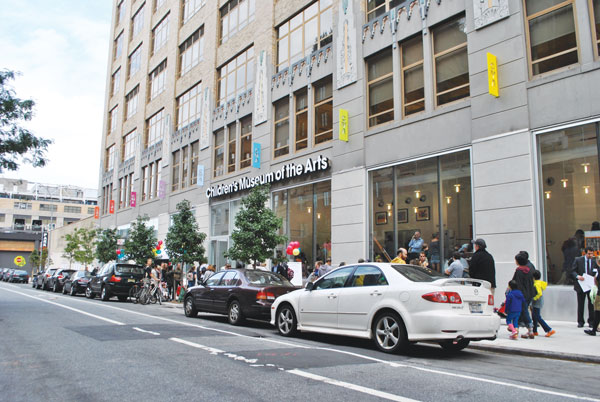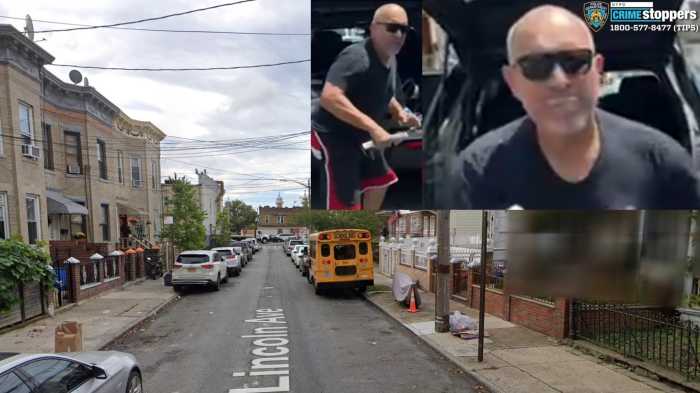
BY JOHN BAYLES | To the random pedestrian walking by, the block of Charlton Street between Hudson and Greenwich Streets must have looked like a circus last Saturday, Oct. 1. There were tents and balloons, kids with painted faces, a police barricade and a line that stretched almost the length of the entire block. It wasn’t Barnum and Baileys however; it was the grand opening of the Children’s Museum of the Arts new Hudson Square home.
David Kaplan, the C.M.A.’s executive director, simply said, “Wow. This has been a long time coming.”
Kaplan was making his rounds early Saturday morning checking in on the children and making sure they were enjoying the organization’s new space and all it offers. From the floor of the building’s lobby he pointed to a huge glass window on the left. The only thing visible was hoards of children bouncing happily on huge yoga balls.
“Talk about last minute,” said Kaplan.
The space, on the building’s second floor, is called the Ball Pond. It is comprised of a giant pit full of bouncy, yoga balls that the children can dive into and blow off steam. The walls are padded and it is completely safe, leaving the parents with only one worry: how they will get their children to stop having so much fun.
The “last minute” remark made by Kaplan did not refer to the idea of the Ball Pond. Indeed the Ball Pond was envisioned as a central space in C.M.A.’s new home. Kaplan was instead referring to how quickly his organization managed to pull off the move and the grand opening in what appeared to be seamless fashion.
The C.M.A. had previously called SoHo home since its inception in 1988. The move to 103 Charlton Street, and the transformation of a former loading dock of an old warehouse building, has all happened over the last 18 months.
The museum, whose collection includes over 2,000 works of art by children from all over the world, began thinking about a move back in 2008. It was then that they reached out to WORK Architecture and to Dan Wood.
“The museum’s board went on a big architectural search in 2008 based on a Wooster Street location,” said Wood. “ We designed a whole museum for that other spot, then there was the recession and the project went dormant.”
Once the economy stabilized, the museum had identified the Hudson Square location as the perfect new home. It is three times larger than their old location and Hudson Square’s new identity as a hub for media companies and nonprofits were both major factors in C.M.A.’s decision.
“We started in SoHo in the 80s” said Lucy Ofiesh, C.M.A.’s director of marketing and special projects. “Now, Hudson Square feels the same way — up and coming.”
And for Wood, when the project started moving again, a change in his own life gave him a heightened appreciation for the museum’s goal.
“My wife and I had a baby,” said Wood. “So the whole project took on a new meaning for me.”
Wood, his wife and their 18-month-old baby were at the museum on Sunday. Wood said watching all of the kids running around the place really drove home the fact that C.M.A. was always stressing safety when it came to designing the new space.
Beyond being safe, the new museum is notable because it allows different types of programming to occur simultaneously while reaching every age group.
One example is the C.M.A.’s “clay bar.” In the old space the “clay bar” was only set up on particular days, but the demand was incredibly strong. The same can be said for the C.M.A.’s “Tech Room,” where the children take their clay figures and begin the animation process.
Now, the children have a fully stocked clay bar that’s always open, where they can pull up a stool at virtually any time and start molding away. Then they simply walk into the “Tech Room” next door, which is also always up and running and they can start on their way to becoming famous film directors.
There are separate spaces for every age group, and for every type of art, not to mention a gallery space on the main. There is also a “quiet room.” But it should be known that the quiet room is the smallest room in the entire museum, a metaphor, one could say, for the museum’s mission, which is to provide children with an atypical museum experience and to encourage as much creativity and hands-on instruction as possible.
And the new home was selected to advance that mission and more importantly to advance the museum’s programming and enlarge its audience.
“The whole point of this was to reach as many children as possible,” said Elizabeth Fearon Pepperman, president of the C.M.A.’s Board of Directors.





























